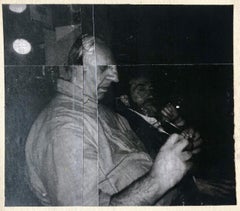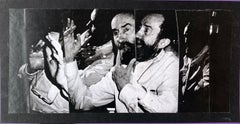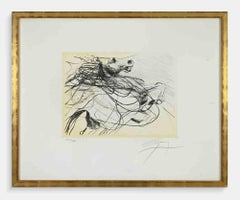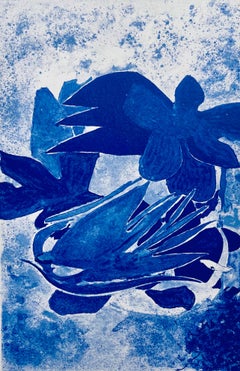Photographic Paper Animal Prints
to
2
Overall Width
to
Overall Height
to
89
3
2
1
2
2
1
2
23,195
786
734
353
275
2
Style: Modern
Medium: Photographic Paper
Vintage Abstract Expressionist Hyman Bloom Photo Collage Assemblage Photograph
Located in Surfside, FL
This is a unique original collage, decoupage style of Jiri Kolar, This is an exceptional artwork which was part of a collaboration between Hyman Bloom and fellow artist and his very ...
Category
1990s Modern Photographic Paper Animal Prints
Materials
Paper, Photographic Paper
Vintage Abstract Expressionist Hyman Bloom Photo Collage Assemblage Photograph
Located in Surfside, FL
This is a unique original collage, decoupage style of Jiri Kolar, This is an exceptional artwork which was part of a collaboration between Hyman Bloom and fellow artist and his very ...
Category
20th Century Modern Photographic Paper Animal Prints
Materials
Paper, Photographic Paper
Related Items
Galloping Horse - Etching by Jean-Marie Guiny - 2000s
Located in Roma, IT
Galloping Horse is an artwork realized by Jean-Marie Guiny, 2000s.
Etching, Edition 145/160.
40 x 50 cm ; with frame.
Hand signed in the lower right part.
Good condtions!
J...
Category
Early 2000s Modern Photographic Paper Animal Prints
Materials
Etching
$374 Sale Price
35% Off
H 15.75 in W 19.69 in D 0.79 in
Composition (Vallier 102), Les Paroles Transparentes, Georges Braque
Located in Southampton, NY
Lithograph on Auvergne du Moulin Richard de Bas filigrané paper. Inscription: Watermarked with the artist's signature and unnumbered, as issued. Good condition. Notes: From the folio...
Category
1950s Modern Photographic Paper Animal Prints
Materials
Lithograph
$2,796 Sale Price
20% Off
H 17 in W 12.75 in
“The Winter Ball” 1988
Located in Austin, TX
Poster Size: 23.5 x 16.5 in.
Vintage Gold Leaf Frame Size: 23.5 x 16.5 in.
Signed and inscribed in gold marker, bottom right
A poster for "The Winter Ball 1988" in Houston, Texas, p...
Category
1980s Pop Art Photographic Paper Animal Prints
Materials
Paper, Lithograph, Offset
Air France, Mediterranee by Roger Bezombes
Located in New York, NY
This lithographic poster was printed in 1981 at the Atelier Mourlot in Paris.
In the early 1970s, Air France commissioned Roger Bezombes to create original artworks capturing the s...
Category
1980s Modern Photographic Paper Animal Prints
Materials
Lithograph
"Unicorn Moebius II" - Trial Proof Lithograph in Ink on Laid Paper
Located in Soquel, CA
"Unicorn Moebius II" - Trial Proof Lithograph in Ink on Laid Paper
High contrast, multi-layer etching by Bruce Weinberg (American, 1942-1994). A moebius strip is shown against a dar...
Category
1980s American Modern Photographic Paper Animal Prints
Materials
Laid Paper, Lithograph
$1,850
H 28.5 in W 34.25 in D 1.25 in
Liberte (Liberty) by Roger Bezombes
Located in New York, NY
This lithographic poster was printed in 1981 at the Atelier Mourlot in Paris.
In the early 1970s, Air France commissioned Roger Bezombes to create original artworks capturing the s...
Category
1980s Modern Photographic Paper Animal Prints
Materials
Lithograph
Original Stone Garden - psychedelic pop-art 1960s vintage poster
Located in Spokane, WA
The original Stone Garden vintage psychedelic 1960s poster is in excellent condition.
The artist is Wilfred Satty (1939 – 1982). German-born collage artist and graphic designer ...
Category
1960s Modern Photographic Paper Animal Prints
Materials
Lithograph
$595
H 35 in W 24 in D 0.2 in
"Nobility" 180/300 Signed Color Serigraph of Abstract Horse and Woman with Lute
Located in Austin, TX
Serigraph on paper
Page Size: 12 x 12 in.
Gold Leaf Frame Size: 21 x 21 in.
Hand Signed, bottom right in black marker
Hand Numbered, bottom left in black marker "180/300"
This strik...
Category
1990s Pop Art Photographic Paper Animal Prints
Materials
Archival Paper, Screen
"Almost Part of Ourselves" Print 28 × 20 in. Edition 1/10 by Kate Garner
By Kate Garner
Located in Culver City, CA
"Almost Part of Ourselves" Print 28 × 20 in. Edition 1/10 by Kate Garner
Signed and numbered by the artist.
Not framed. Ships in a tube.
Kate Garner is an English photographer, fine artist, and singer. Garner has photographed a wide range of musicians and celebrities, including Dr. Dre, Leigh Bowery, JT LeRoy, Angelina Jolie, Cate Blanchett, Anne Hathaway, David Bowie, Cameron Diaz, PJ Harvey, John Galliano, Björk, and Kate Moss.
Her work has appeared in the American and British versions of Vogue and Harper’s Bazaar as well as W magazine, Interview, GQ, Vanity Fair, Elle, and The Sunday Times.
Kate Garner was expelled from high school at the age of 16 and became a runaway who joined The Children Of God. To escape the grasp of the cult she hitchhiked from London through Eastern Europe to India in 1970, where she lived for a year as a traveler before being located by her parents. She attended art school at Blackpool in the North of England and later moved to London, where she began to both photograph and model for up-and-coming magazines such as The Face and i-D.
Kate Garner first came widely into the public eye as one-third of the 1980s avant-garde, new wave pop project Haysi Fantayzee, along with other members Jeremy Healy and Paul Caplin. Emanating from street art scenes such as the Blitz Kids that were cropping up in London in the early 1980s, Haysi’s music combined reggae, country, and electro with political and sociological lyrics couched as nursery rhymes.
Catapulted to stardom by their visual sensibilities, Haysi Fantayzee combined their extreme clothes sense – described as combining white Rasta, tribal chieftain, and Dickensian styles – with a quirky musical sound comparable to other new wave musical pop acts of the era, such as Bow Wow Wow, Adam and the Ants and Bananarama. They appeared several times on the BBC Television program Top of the Pops. Despite being touted by Bowie producer Tony Visconti as the next big thing, the group quickly disbanded after releasing three hit singles “John Wayne Is Big Leggy”, “Shiny Shiny”, and “Holy Joe”, and an album, Battle Hymns for Children Singing, that went gold.
Garner then returned to painting, photography, and video, launching a successful media arts career, starting with her collaboration with Sinéad O’Connor...
Category
21st Century and Contemporary Pop Art Photographic Paper Animal Prints
Materials
Archival Ink, Archival Paper
The Philosopher's Conquest
By Marc Dennis
Located in New York, NY
ABOUT THIS PIECE: The Philosopher's Conquest is from the artists last show, An Artist, A Curator And A Rabbi Walk Into A Bar...,.The title of the exhib...
Category
2010s Photographic Paper Animal Prints
Materials
Photographic Paper
"This our Court infected by their Manners" Print 48×40in Ed. 1/10 by Kate Garner
By Kate Garner
Located in Culver City, CA
"This our Court infected by their Manners" Print 48×40in Ed. 1/10 by Kate Garner
Signed and numbered by the artist.
Not framed. Ships in a tube.
Kate Garner is an English photographer, fine artist, and singer. Garner has photographed a wide range of musicians and celebrities, including Dr. Dre, Leigh Bowery, JT LeRoy, Angelina Jolie, Cate Blanchett, Anne Hathaway, David Bowie, Cameron Diaz, PJ Harvey, John Galliano, Björk, and Kate Moss.
Her work has appeared in the American and British versions of Vogue and Harper’s Bazaar as well as W magazine, Interview, GQ, Vanity Fair, Elle, and The Sunday Times.
Kate Garner was expelled from high school at the age of 16 and became a runaway who joined The Children Of God. To escape the grasp of the cult she hitchhiked from London through Eastern Europe to India in 1970, where she lived for a year as a traveler before being located by her parents. She attended art school at Blackpool in the North of England and later moved to London, where she began to both photograph and model for up-and-coming magazines such as The Face and i-D.
Kate Garner first came widely into the public eye as one-third of the 1980s avant-garde, new wave pop project Haysi Fantayzee, along with other members Jeremy Healy and Paul Caplin. Emanating from street art scenes such as the Blitz Kids that were cropping up in London in the early 1980s, Haysi’s music combined reggae, country, and electro with political and sociological lyrics couched as nursery rhymes.
Catapulted to stardom by their visual sensibilities, Haysi Fantayzee combined their extreme clothes sense – described as combining white Rasta, tribal chieftain, and Dickensian styles – with a quirky musical sound comparable to other new wave musical pop acts of the era, such as Bow Wow Wow...
Category
21st Century and Contemporary Pop Art Photographic Paper Animal Prints
Materials
Archival Ink, Archival Paper
$2,000
H 47.5 in W 40 in D 0.1 in
"The New Created World" Abstract Print 43" × 40" in Ed. 1/10 by Kate Garner
By Kate Garner
Located in Culver City, CA
"The New Created World" Abstract Print 43" × 40" in Ed. 1/10 by Kate Garner
Signed and numbered by the artist.
Not framed. Ships in a tube.
Kate Garner is an English photographer, fine artist, and singer. Garner has photographed a wide range of musicians and celebrities, including Dr. Dre, Leigh Bowery, JT LeRoy, Angelina Jolie, Cate Blanchett, Anne Hathaway, David Bowie, Cameron Diaz, PJ Harvey, John Galliano, Björk, and Kate Moss.
Her work has appeared in the American and British versions of Vogue and Harper’s Bazaar as well as W magazine, Interview, GQ, Vanity Fair, Elle, and The Sunday Times.
Kate Garner was expelled from high school at the age of 16 and became a runaway who joined The Children Of God. To escape the grasp of the cult she hitchhiked from London through Eastern Europe to India in 1970, where she lived for a year as a traveler before being located by her parents. She attended art school at Blackpool in the North of England and later moved to London, where she began to both photograph and model for up-and-coming magazines such as The Face and i-D.
Kate Garner first came widely into the public eye as one-third of the 1980s avant-garde, new wave pop project Haysi Fantayzee, along with other members Jeremy Healy and Paul Caplin. Emanating from street art scenes such as the Blitz Kids that were cropping up in London in the early 1980s, Haysi’s music combined reggae, country, and electro with political and sociological lyrics couched as nursery rhymes.
Catapulted to stardom by their visual sensibilities, Haysi Fantayzee combined their extreme clothes sense – described as combining white Rasta, tribal chieftain, and Dickensian styles – with a quirky musical sound comparable to other new wave musical pop acts of the era, such as Bow Wow Wow...
Category
21st Century and Contemporary Pop Art Photographic Paper Animal Prints
Materials
Archival Ink, Archival Paper
$1,600 Sale Price
20% Off
H 43 in W 40 in D 0.1 in
Previously Available Items
Vintage Abstract Expressionist Hyman Bloom Photo Collage Assemblage Photograph
Located in Surfside, FL
This is a unique original collage, decoupage style of Jiri Kolar, This is an exceptional artwork which was part of a collaboration between Hyman Bloom and fellow artist and his very good friend Martin Sumers. This is pencil signed by Martin Sumers.
Provenance: Acquired from the Sumers estate collection.
Hyman Bloom (March 29, 1913 – August 26, 2009) was a Latvian-born American painter. His work was influenced by his Jewish heritage and Eastern religions as well as by artists including Altdorfer, Grünewald, Caravaggio, Rembrandt, Blake, Bresdin, James Ensor and Chaim Soutine. He first came to prominence when his work was included in the 1942 Museum of Modern Art exhibition "Americans 1942 -- 18 Artists from 9 States". MoMA purchased 2 paintings from the exhibition and Time magazine singled him out as a "striking discovery" in their exhibition review.
His work was selected for both the 1948 and 1950 Venice Biennale exhibitions and his 1954 retrospective traveled from Boston's Institute of Contemporary Art to the Albright Gallery and the de Young Museum before closing out at The Whitney Museum of American Art in 1955. In a 1954 interview with Yale art professor Bernard Chaet, Willem de Kooning indicated that he and Jackson Pollock both considered Bloom to be “America’s first abstract expressionist”, a label that Bloom would disavow. Starting in the mid 1950s his work began to shift more towards works on paper and he exclusively focused on drawing throughout the 1960s, returning to painting in 1971. He continued both drawing and painting until his death in 2009 at the age of 9
Hyman Bloom (né Melamed) was born into an orthodox Jewish family in the tiny Jewish village of Brunavišķi in what is now Latvia, then part of the Russian Empire
At a young age Bloom planned to become a rabbi, but his family could not find a suitable teacher. In the eighth grade he received a scholarship to a program for gifted high school students at the Museum of Fine Arts. He attended the Boston High School of Commerce, which was near the museum. He also took art classes at the West End Community Center, a settlement house. The classes were taught by Harold Zimmerman, a student at the School of the Museum of Fine Arts, who also taught the young Jack Levine at another settlement house in Roxbury. When Bloom was fifteen, he and Levine began studying with a well-known Harvard art professor, Denman Ross, who rented a studio for the purpose and paid the boys a weekly stipend to enable them to continue their studies rather than take jobs to support their families.
He took Bloom and Levine on a field trip to the Museum of Modern Art in New York, where Bloom was impressed by the work of Rouault and Soutine and began experimenting with their expressive painting styles.
In the 1930s Bloom worked sporadically for the Public Works of Art Project and the Federal Art Project (WPA), He shared a studio in the South End with Levine and another artist, Betty Chase. It was during this period that he developed a lifelong interest in Eastern philosophy and music, and in Theosophy.
He first received national attention in 1942 when thirteen of his paintings were included in the Museum of Modern Art (MoMA) exhibition Americans 1942: 18 Artists from 9 States, curated by Dorothy Miller. MoMA purchased two of his paintings from that exhibition, and he was featured in Time magazine. The titles of his paintings in the exhibition reflect some of his recurring themes. Two were titled The Synagogue, another, Jew with the Torah; Bloom was actually criticized by one reviewer for including "stereotypical" Jewish images. He also had two paintings titled The Christmas Tree, and another titled The Chandelier, both subjects he returned to repeatedly. Another, Skeleton (c. 1936), was followed by a series of cadaver paintings in the forties, and The Fish (c. 1936) was one of many paintings and drawings of fish he created over the course of his career.
Bloom was associated at first with the growing Abstract Expressionist movement. Willem de Kooning and Jackson Pollock, who first saw Bloom's work at the MoMA exhibition, considered Bloom "the first Abstract Expressionist artist in America." In 1950 he was chosen, along with the likes of de Kooning, Pollock, and Arshile Gorky, to represent the United States at the Venice Biennale. That same year Elaine de Kooning wrote about Bloom in ARTnews, noting that in paintings such as The Harpies, his work approached total abstraction: "the whole impact is carried in the boiling action of the pigment". In 1951 Thomas B. Hess reproduced Bloom's Archaeological Treasure in his first book, Abstract Painting: Background and American Phase, along with works by Picasso, Pollock, and others. Both de Kooning and Hess remarked on Bloom's expressive paint handling, a key characteristic of Abstract Expressionist painting.
As abstract expressionism dominated the American art world, Bloom became disenchanted with it, calling it "emotional catharsis, with no intellectual basis." In addition, instead of moving to New York to pursue his career, he opted to stay in Boston. As a result he fell out of favor with critics and never achieved the kind of fame that Pollock and others did. He disliked self-promotion and never placed much value on critical acclaim.
Many of Bloom's paintings feature rabbis, usually holding the Torah. According to Bloom, his intentions were more artistic than religious. He began questioning his Jewish faith early in life, and painted rabbis, he claimed, because that was what he knew. Over the course of his career he produced dozens of paintings of rabbis...
Category
1990s Modern Photographic Paper Animal Prints
Materials
Paper, Photographic Paper
Vintage Abstract Expressionist Hyman Bloom Photo Collage Assemblage Photograph
Located in Surfside, FL
This is a unique original collage, decoupage style of Jiri Kolar, This is an exceptional artwork which was part of a collaboration between Hyman Bloom and fellow artist and his very good friend Martin Sumers. This is pencil signed by Martin Sumers.
Provenance: Acquired from the Sumers estate collection.
Hyman Bloom (March 29, 1913 – August 26, 2009) was a Latvian-born American painter. His work was influenced by his Jewish heritage and Eastern religions as well as by artists including Altdorfer, Grünewald, Caravaggio, Rembrandt, Blake, Bresdin, James Ensor and Chaim Soutine. He first came to prominence when his work was included in the 1942 Museum of Modern Art exhibition "Americans 1942 -- 18 Artists from 9 States". MoMA purchased 2 paintings from the exhibition and Time magazine singled him out as a "striking discovery" in their exhibition review.
His work was selected for both the 1948 and 1950 Venice Biennale exhibitions and his 1954 retrospective traveled from Boston's Institute of Contemporary Art to the Albright Gallery and the de Young Museum before closing out at The Whitney Museum of American Art in 1955. In a 1954 interview with Yale art professor Bernard Chaet, Willem de Kooning indicated that he and Jackson Pollock both considered Bloom to be “America’s first abstract expressionist”, a label that Bloom would disavow. Starting in the mid 1950s his work began to shift more towards works on paper and he exclusively focused on drawing throughout the 1960s, returning to painting in 1971. He continued both drawing and painting until his death in 2009 at the age of 9
Hyman Bloom (né Melamed) was born into an orthodox Jewish family in the tiny Jewish village of Brunavišķi in what is now Latvia, then part of the Russian Empire
At a young age Bloom planned to become a rabbi, but his family could not find a suitable teacher. In the eighth grade he received a scholarship to a program for gifted high school students at the Museum of Fine Arts. He attended the Boston High School of Commerce, which was near the museum. He also took art classes at the West End Community Center, a settlement house. The classes were taught by Harold Zimmerman, a student at the School of the Museum of Fine Arts, who also taught the young Jack Levine at another settlement house in Roxbury. When Bloom was fifteen, he and Levine began studying with a well-known Harvard art professor, Denman Ross, who rented a studio for the purpose and paid the boys a weekly stipend to enable them to continue their studies rather than take jobs to support their families.
He took Bloom and Levine on a field trip to the Museum of Modern Art in New York, where Bloom was impressed by the work of Rouault and Soutine and began experimenting with their expressive painting styles.
In the 1930s Bloom worked sporadically for the Public Works of Art Project and the Federal Art Project (WPA), He shared a studio in the South End with Levine and another artist, Betty Chase. It was during this period that he developed a lifelong interest in Eastern philosophy and music, and in Theosophy.
He first received national attention in 1942 when thirteen of his paintings were included in the Museum of Modern Art (MoMA) exhibition Americans 1942: 18 Artists from 9 States, curated by Dorothy Miller. MoMA purchased two of his paintings from that exhibition, and he was featured in Time magazine. The titles of his paintings in the exhibition reflect some of his recurring themes. Two were titled The Synagogue, another, Jew with the Torah; Bloom was actually criticized by one reviewer for including "stereotypical" Jewish images. He also had two paintings titled The Christmas Tree, and another titled The Chandelier, both subjects he returned to repeatedly. Another, Skeleton (c. 1936), was followed by a series of cadaver paintings in the forties, and The Fish (c. 1936) was one of many paintings and drawings of fish he created over the course of his career.
Bloom was associated at first with the growing Abstract Expressionist movement. Willem de Kooning and Jackson Pollock, who first saw Bloom's work at the MoMA exhibition, considered Bloom "the first Abstract Expressionist artist in America." In 1950 he was chosen, along with the likes of de Kooning, Pollock, and Arshile Gorky, to represent the United States at the Venice Biennale. That same year Elaine de Kooning wrote about Bloom in ARTnews, noting that in paintings such as The Harpies, his work approached total abstraction: "the whole impact is carried in the boiling action of the pigment". In 1951 Thomas B. Hess reproduced Bloom's Archaeological Treasure in his first book, Abstract Painting: Background and American Phase, along with works by Picasso, Pollock, and others. Both de Kooning and Hess remarked on Bloom's expressive paint handling, a key characteristic of Abstract Expressionist painting.
As abstract expressionism dominated the American art world, Bloom became disenchanted with it, calling it "emotional catharsis, with no intellectual basis." In addition, instead of moving to New York to pursue his career, he opted to stay in Boston. As a result he fell out of favor with critics and never achieved the kind of fame that Pollock and others did. He disliked self-promotion and never placed much value on critical acclaim.
Many of Bloom's paintings feature rabbis, usually holding the Torah. According to Bloom, his intentions were more artistic than religious. He began questioning his Jewish faith early in life, and painted rabbis, he claimed, because that was what he knew. Over the course of his career he produced dozens of paintings of rabbis...
Category
20th Century Modern Photographic Paper Animal Prints
Materials
Paper, Photographic Paper
Photographic Paper animal prints for sale on 1stDibs.
Find a wide variety of authentic Photographic Paper animal prints available on 1stDibs. While artists have worked in this medium across a range of time periods, art made with this material during the 21st Century is especially popular. If you’re looking to add animal prints created with this material to introduce a provocative pop of color and texture to an otherwise neutral space in your home, the works available on 1stDibs include elements of blue, green, purple and other colors. There are many well-known artists whose body of work includes ceramic sculptures. Popular artists on 1stDibs associated with pieces like this include Randal Ford, James Lewin, Raphael Macek, and Kyriakos Kaziras. Frequently made by artists working in the Contemporary, Modern, all of these pieces for sale are unique and many will draw the attention of guests in your home. Not every interior allows for large Photographic Paper animal prints, so small editions measuring 0.5 inches across are also available
Recently Viewed
View AllMore Ways To Browse
Manetti Saverio
Natural History Museum Vintage Prints
Penguin Lithograph
Peter Klucik
Pheasant Engraving
Picasso Dove Of Peace
Picasso Le Taureau
Picasso Rooster
Ronald Smith
Rooster Print Picasso
Salvador Dali Argus
Salvador Dali Unicorn
Sam Savitt
Shore Bird Print
Space Elephant Dali
Szabolcs Bozo
The Toad Picasso
Vintage Forest Service Posters





